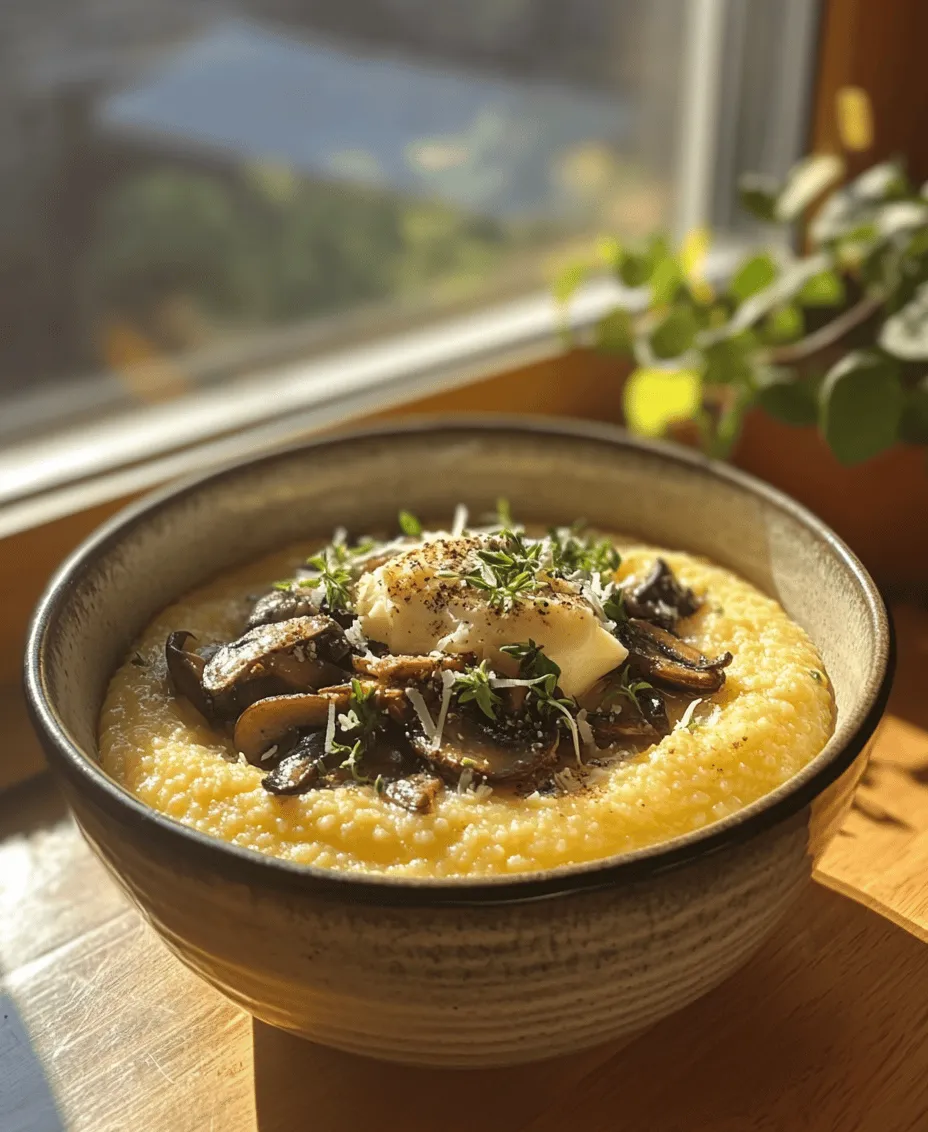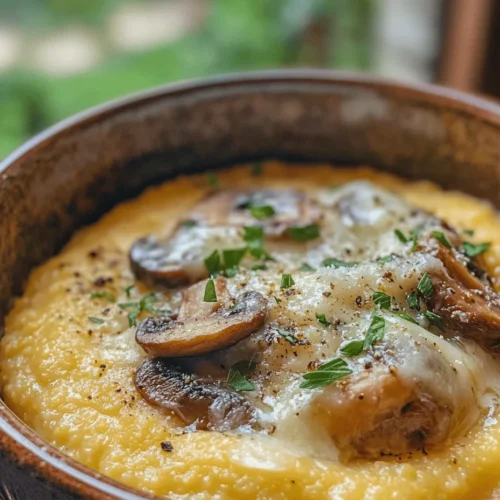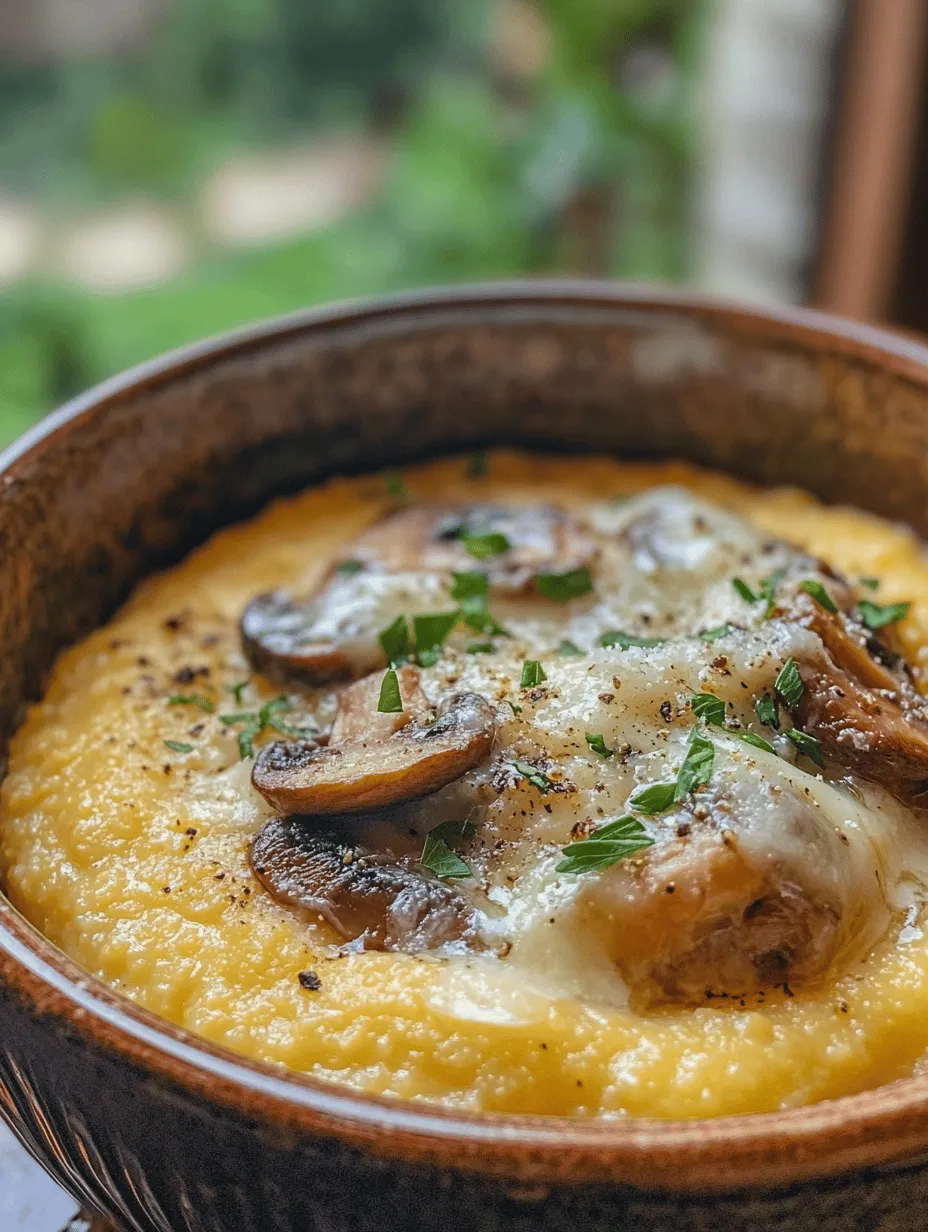Introduction
Polenta, a dish rooted deeply in Italian culinary tradition, has transcended its humble origins to become a beloved comfort food across the globe. Made primarily from cornmeal, polenta boasts a creamy texture that can be enjoyed in a multitude of ways—served as a side dish, a base for hearty toppings, or even allowed to set and be sliced into delectable shapes. Its versatility is unmatched, making it a staple in many kitchens, whether rustic or refined.
In this article, we will guide you step-by-step through the process of making perfectly creamy polenta from scratch. With simple yet essential ingredients and straightforward instructions, you will discover how to transform this classic dish into a culinary masterpiece that enhances any meal. Whether you are looking to impress dinner guests or simply enjoy a comforting bowl on a chilly evening, our ultimate recipe will ensure you achieve delicious results every time.
Understanding Polenta
Defining Polenta
At its core, polenta is a dish consisting of ground cornmeal cooked in water or broth to create a thick, creamy porridge. It can be served immediately for a warm side dish or allowed to cool and firm up for slicing and grilling. The beauty of polenta lies in its adaptability; it can be flavored with an array of ingredients, making it suitable for both savory and sweet dishes.
Exploring the Origins and History of Polenta
The origins of polenta can be traced back to ancient times, where it was enjoyed by various cultures, including the Romans. However, it became particularly popular in Northern Italy, especially in regions like Lombardy and Piedmont, where corn became a staple crop after its introduction from the Americas in the 16th century. Traditionally, polenta was made with coarse cornmeal, stirred constantly over an open flame, a process that required skill and patience.
Over the years, polenta has evolved, and its preparation has been simplified with modern cooking methods. Today, it is celebrated not only for its rich history but also for its ability to absorb flavors from accompanying ingredients, making it a versatile canvas for chefs and home cooks alike.
Nutritional Benefits of Polenta
Polenta is not only a delicious dish but also offers several nutritional benefits. As a corn-based product, it is naturally gluten-free, making it an excellent choice for individuals with gluten sensitivities. Additionally, polenta is high in carbohydrates, providing a substantial energy source. It is also low in calories and contains several important nutrients, including fiber, B vitamins, and antioxidants.
Polenta can be an excellent option for those looking to incorporate whole grains into their diet. When made with whole grain cornmeal, it offers even more fiber and nutrients. By choosing to make polenta at home, you can control the ingredients and enhance its health benefits with the addition of vegetables, herbs, and healthy fats.
Different Types of Polenta: Coarse vs. Fine
When selecting cornmeal for polenta, you will encounter two primary types: coarse and fine. Coarse cornmeal creates a heartier texture, while fine cornmeal yields a smoother, creamier polenta. The choice between the two largely depends on personal preference and the desired consistency of the final dish.
For a classic creamy polenta, many cooks prefer using medium to fine cornmeal, which allows for a velvety finish. However, if you enjoy a more rustic texture, coarse cornmeal can add a satisfying bite. Both types can be used effectively, and experimenting with different textures can lead to delightful variations in your polenta dishes.
Essential Ingredients for Perfect Polenta
Highlighting the Key Ingredients
To create perfectly creamy polenta, you will need just a few essential ingredients:
1. Cornmeal: The star of the show, cornmeal is the foundation of polenta. Look for high-quality cornmeal, preferably stone-ground, for the best flavor and texture.
2. Water or Broth: The cooking liquid is crucial in determining the flavor of your polenta. Water can be used for a plain taste, while vegetable or chicken broth adds depth and richness.
3. Salt: Essential for enhancing flavor, salt should be added to the cooking liquid to ensure even seasoning.
4. Butter and Cheese: For a decadent finish, butter and cheese can be stirred into the finished polenta for added creaminess and flavor.
The Role of Polenta (Coarse Cornmeal)
Polenta is made from ground corn, which can vary in grind size. The type of cornmeal you choose will impact the cooking time and texture of your final dish. Coarser cornmeal takes longer to cook and results in a chunkier polenta, while finer varieties cook more quickly and create a smoother consistency.
When purchasing cornmeal, opt for a stone-ground variety if possible, as it retains more of the corn’s natural oils and flavors compared to finely processed options. This choice will enhance the overall taste of your polenta and provide a more authentic experience.
Choosing Between Water and Vegetable Broth
The choice of cooking liquid is a significant factor in the flavor profile of your polenta. While water is a suitable option, using vegetable or chicken broth can elevate the dish by imparting additional layers of flavor.
If you want to keep the dish vegetarian or vegan, vegetable broth is an excellent choice. It complements the natural sweetness of the corn and enhances the overall taste of polenta. Additionally, consider infusing the broth with herbs or aromatics beforehand for an even richer flavor base.
Understanding the Importance of Salt
Salt is a crucial ingredient in cooking, and polenta is no exception. Adding salt to your cooking liquid not only enhances the flavor but also helps balance the sweetness of the corn.
When preparing polenta, it’s best to add salt to the water or broth before bringing it to a boil. This ensures that the salt is evenly distributed throughout the polenta as it cooks. The general rule of thumb is to use about one teaspoon of salt for every four cups of liquid, but feel free to adjust according to your taste preferences.
Enhancing Flavor with Butter and Cheese
For those looking to take their creamy polenta to the next level, consider finishing it with butter and cheese. A couple of tablespoons of butter will add richness and depth, creating a luxurious mouthfeel.
Cheese, such as Parmesan, Pecorino, or even creamy goat cheese, can be stirred into the polenta just before serving. This not only enhances flavor but also adds a delightful creaminess. The heat from the polenta will melt the cheese, creating a harmonious blend that elevates the dish.
Vegan Alternatives: Nutritional Yeast
If you’re preparing a vegan version of polenta, nutritional yeast is an excellent alternative to cheese. This ingredient adds a cheesy, umami flavor without any dairy. Simply stir in a few tablespoons of nutritional yeast at the end of cooking to enrich your polenta and provide a boost of B vitamins.
Optional Toppings: Herbs, Vegetables, and More
One of the best aspects of polenta is its versatility when it comes to toppings. While it can be enjoyed plain, adding various toppings can transform your dish into a culinary delight.
Consider sautéing seasonal vegetables, such as mushrooms, spinach, or bell peppers, and serving them atop your creamy polenta. Fresh herbs like basil, thyme, or chives can also add a burst of flavor and a pop of color. For a heartier meal, try layering polenta with stews, braised meats, or even a rich tomato sauce. The possibilities are endless, allowing you to customize your polenta to suit any occasion.
Step-by-Step Guide to Cooking Creamy Polenta
Preparing Your Cooking Space
Before you begin cooking, it’s essential to prepare your cooking space for a smooth and enjoyable experience. Gather all your ingredients and equipment, ensuring you have everything at hand. You will need:
– A medium to large saucepan
– A whisk or wooden spoon for stirring
– A measuring cup for liquid and cornmeal
– A heatproof spatula or spoon for serving
Having everything organized will make the cooking process more efficient and help prevent any last-minute scrambling for ingredients.
Gathering Ingredients and Equipment
Here’s a quick checklist of what you’ll need to make perfectly creamy polenta:
– 1 cup of cornmeal (fine or medium grind)
– 4 cups of water or vegetable broth
– 1 teaspoon of salt (adjust to taste)
– 2 tablespoons of butter (optional)
– ½ cup of grated cheese (Parmesan or your favorite) (optional)
– Additional toppings (vegetables, herbs, etc.) as desired
Make sure to measure out your ingredients before starting to cook, as this will help you stay organized and focused on the process.
Bringing Water or Broth to a Boil
The first step in cooking polenta is to bring your chosen liquid to a boil. In a medium saucepan, combine the water or broth with salt, and place it over medium-high heat. Stir occasionally to ensure the salt is dissolved properly.
Once the liquid reaches a rolling boil, reduce the heat to medium-low to allow for a gentle simmer. At this point, you can begin incorporating the cornmeal into the boiling liquid, which will lead us into the next stage of this creamy polenta adventure.
Stay tuned for the next part of this article, where we will guide you through the crucial steps of cooking and finishing your polenta for the perfect creamy texture.

Whisking in the Polenta: Techniques to Avoid Clumping
To achieve the perfect creamy polenta, the technique of whisking is crucial. When incorporating the polenta into the boiling liquid, it’s essential to add it gradually while continuously whisking. This method helps prevent clumping, ensuring a smooth and velvety texture. Start by bringing your water or broth to a vigorous boil in a large saucepan. Once boiling, lower the heat to medium and begin to whisk vigorously. Slowly sprinkle the polenta into the liquid in a thin, steady stream. The whisking motion should be consistent, allowing the polenta to absorb the liquid evenly.
If you encounter any lumps during the process, don’t fret! Simply switch to a sturdy wooden spoon and stir continuously until the lumps dissolve. This technique not only ensures a lump-free polenta but also introduces air into the mixture, contributing to a lighter texture.
Cooking Time: Achieving the Right Consistency
The cooking time for polenta is essential to achieving the right consistency. Once you’ve whisked in the polenta, reduce the heat to low and allow it to simmer. The general rule of thumb for cooking time is about 30 to 40 minutes, but this can vary depending on the grind of your cornmeal. Instant polenta cooks much faster, usually within 5 to 10 minutes, while traditional polenta requires more time for the grains to soften and swell.
During cooking, stir the polenta frequently to prevent sticking and to ensure even cooking. You want to achieve a creamy consistency that holds its shape when served. If the polenta seems too thick, you can add additional water or broth, a little at a time, until you reach your desired creaminess. Conversely, if it’s too thin, let it cook a bit longer to thicken up.
Incorporating Butter and Cheese for Creaminess
For that ultimate creamy texture, incorporating butter and cheese into your polenta is a game changer. Once your polenta is cooked to perfection, remove it from the heat, and stir in a generous knob of unsalted butter. The butter adds a rich flavor and enhances the creaminess of the dish.
Next, choose your cheese. Grated Parmesan, Pecorino Romano, or creamy goat cheese are excellent options. Stir in the cheese while the polenta is still hot so that it melts thoroughly, creating a luscious, smooth consistency. You can adjust the amount of cheese according to your taste, but a good starting point is about ½ cup for every cup of polenta used.
Adjusting Flavor: Seasoning Tips
Seasoning is crucial in elevating the flavor of your polenta. Start by salting the boiling water before adding the polenta; this step ensures the grains absorb flavor as they cook. After incorporating the butter and cheese, taste your polenta and adjust the seasoning with salt and freshly ground black pepper.
For additional flavor profiles, consider mixing in roasted garlic, sautéed onions, or fresh herbs like thyme or rosemary. A splash of high-quality olive oil or a hint of lemon juice can also brighten the dish. Don’t hesitate to experiment with spices such as smoked paprika or chili flakes for an extra kick.
Creative Serving Suggestions
Polenta is incredibly versatile and can be served in various delightful ways. Here are some ideas to inspire your creativity in the kitchen:
Serving Polenta as a Side Dish
Polenta makes a wonderful side dish that pairs beautifully with meats and vegetables. Serve it alongside roasted chicken, grilled steak, or braised pork. A simple drizzle of balsamic reduction or a sprinkle of microgreens can elevate your dish’s presentation and flavor.
Transforming Polenta into a Main Course
For a hearty main course, consider a polenta bowl. Start with a base of creamy polenta, then add sautéed vegetables, beans, or a meat of your choice. Top with a fried egg for a delightful brunch option or incorporate a rich tomato sauce for an Italian-inspired meal.
Ideas for Toppings: Sautéed Mushrooms and Roasted Vegetables
Sautéed mushrooms are a classic pairing with polenta, adding earthy flavors and a meaty texture. Simply sauté a mix of your favorite mushrooms in olive oil with garlic and fresh thyme until golden brown.
Roasted vegetables, such as bell peppers, zucchini, and carrots, also complement polenta nicely. Toss them in olive oil, salt, and pepper, and roast until tender and caramelized. These toppings add a nutritious and colorful element to your dish.
Incorporating Fresh Herbs for Added Flavor
Fresh herbs bring a burst of flavor to your polenta. Consider stirring in chopped fresh basil, parsley, or chives right before serving. They not only enhance the taste but also add a vibrant color to your dish.
Storing and Reheating Polenta
Polenta is best enjoyed fresh, but if you have leftovers, proper storage and reheating techniques can help maintain its creamy texture.
Tips for Cooling and Setting Polenta
If you plan to use polenta in a different form, such as polenta cakes, let it cool in the pot for about 10 minutes before transferring it to a greased baking dish. Spread the polenta evenly and smooth the top with a spatula. Allow it to cool completely at room temperature, then cover and refrigerate. This cooling process helps it set, making it easier to cut into shapes later.
Best Practices for Storing Leftovers
Store leftover polenta in an airtight container in the refrigerator for up to 4 days. If the polenta thickens too much in the fridge, you can always rehydrate it with a little water or broth when reheating.
Reheating Polenta: Techniques for Maintaining Creaminess
To reheat polenta, place it in a saucepan with a splash of water or broth over low heat. Stir continuously until heated through and creamy again. Alternatively, you can microwave it in short intervals, stirring in between until it reaches your desired consistency.
Exploring Variations of Polenta
Polenta can be fun to experiment with, and there are many variations to suit different tastes.
Different Flavor Profiles: Sweet vs. Savory
While polenta is typically served savory, it can also be transformed into a sweet dish. For a breakfast treat, cook your polenta with milk instead of water, and sweeten it with honey or maple syrup. Top with fresh fruit and nuts for a nutritious start to your day.
Incorporating Seasonal Ingredients
Use seasonal ingredients to enhance the flavor of your polenta. In the fall, add roasted butternut squash and sage for a comforting dish. In the summer, fresh tomatoes and basil can brighten up your polenta, making it a refreshing option.
Polenta Cakes: A New Way to Enjoy Polenta
Once cooled and set, you can cut the polenta into squares or circles and pan-fry them until crispy. These polenta cakes can be served as appetizers topped with various toppings, such as marinated vegetables or a dollop of pesto. They also make a fantastic base for a hearty meal when paired with sauces and meats.
Conclusion
Perfectly creamy polenta is an achievable dish that can serve as a comforting side or a hearty main course. With simple ingredients and easy-to-follow instructions, anyone can master this classic recipe. By exploring various toppings and serving suggestions, you can personalize your polenta experience to suit your taste. Embrace the versatility of this dish and enjoy the warm, creamy comfort it brings to your table. Whether you’re serving it as a side, transforming it into a main course, or experimenting with unique variations, polenta is sure to become a favorite in your culinary repertoire.


